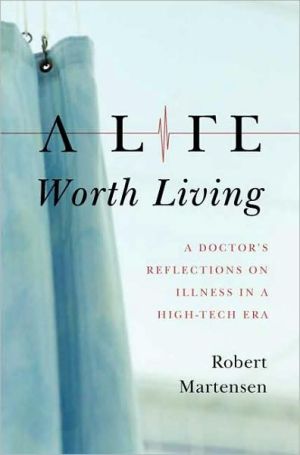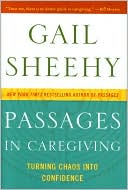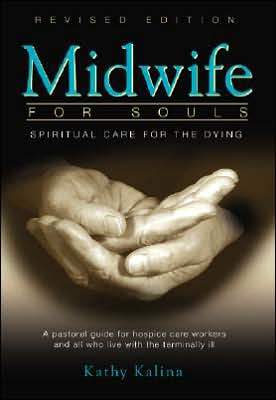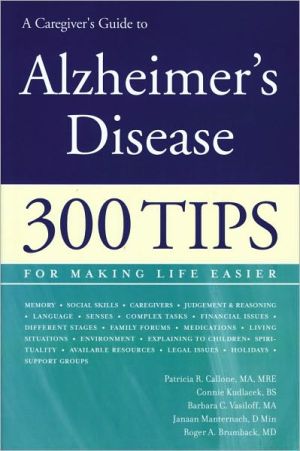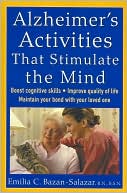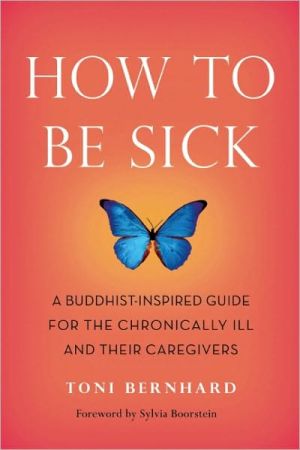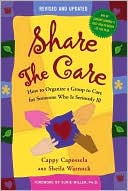A Life Worth Living: A Doctor's Reflections on Illness in a High-Tech Era
Critical illness is a fact of life. Even those of us who enjoy decades of good health are touched by it eventually, either in our own lives or in those of our loved ones. And when this happens, we grapple with serious and often confusing choices about how best to live with our afflictions.\ A Life Worth Living is a book for people facing these difficult decisions. Dr. Robert Martensen draws on decades of experience with patients and friends to explore the life cycle of serious illness. He...
Search in google:
Critical illness is a fact of life. Even those of us who enjoy decades of good health are touched by it eventually, either in our own lives or in those of our loved ones. And when this happens, we grapple with serious and often confusing choices about how best to live with our afflictions.A Life Worth Living is a book for people facing these difficult decisions. Dr. Robert Martensen draws on decades of experience with patients and friends to explore the life cycle of serious illness. He connects personal stories with reflections on mortality, human agency, and the value of cutting-edge technology in caring for the critically ill. Timely questions emerge: To what extent should efforts to extend human life be made? What is the value of nontraditional medical treatment? How has the American healthcare system affected treatment of the critically ill? And finally, what are our doctors’ responsibilities to us as patients, and where do those responsibilities end?Using poignant case studies, Martensen demonstrates how we and our loved ones can maintain dignity and resilience in the face of life’s most daunting circumstances. Publishers Weekly A physician, medical historian and bioethicist, Martensen pulls no punches: beyond the marvels of modern medical technology "lies a treacherous morass of ethical, moral and spiritual dilemmas most of us are not ready to even consider: whether to opt for aggressive treatments, when to stop them, and how to die "well." Too often the choice of aggressive treatment and heroic measures becomes an extended "death by intensive care"' in grim hospital units designed more like prisons than places of healing. Thoughtful and compassionate, Martensen narrates poignant case studies, such as that of Marguerite, who undergoes ineffective surgeries and drug trials for advanced breast cancer but has debilitating side effects. The author lays blame across the board, from patients with unrealistic expectations and doctors who don't explain treatment options fully, from profit-driven hospitals to an insurance bureaucracy that spurns routine health maintenance. Martensen makes his case with clear, compelling writing that never flinches from his conclusion that some things you just can't "win the battle against"; you can only hope for quality of life until the end. (Sept.)Copyright © Reed Business Information, a division of Reed Elsevier Inc. All rights reserved.
Life Worth Living, A\ 1\ Trials of the Body\ In my experience, most people with something worrisome about their health seek out doctors because they want to know the truth, even when it hurts. Then they want the best available treatment. For decades, patients who follow recommended treatment regimes have been called “compliant” among doctors and nurses. The Oxford English Dictionary gives one definition of comply as “bending to the will of others.” But when it comes to living with a life-threatening disease that admits of no cure but many treatment options, what role does “bending” play for both patients and doctors? What does compliance mean when all of us live within a biomedical-industrial complex that has its own values, assumptions, and interests to promote? Though any one of us within “the system” may strive to behave with candor and mindful compassion toward everyone, including ourselves, does “the system” encourage either?\ This chapter tells the story of a woman who discovered when she was forty that she had advanced breast cancer. But the challenges she faced are similar to those contemplating aggressive treatments for other life-threatening diagnoses, such as advanced cardiovascular disease and degenerative conditions of the nervous system.\ MARGUERITE AND THE PILGRIM HOSPITAL, BOSTON\ In ERs, doctors and patients ordinarily meet as strangers. I was a little surprised, therefore, one Sunday morning in Boston in the mid-1990s, when I got a telephone call at home from a new neighbor asking if I would see her when I next worked in the ER at the Pilgrim, one of Harvard’s principal teaching hospitals. I had met Marguerite and her husband, Eduardo, at a welcoming party another neighbor gave for them. It turned out she was the younger sister of a college classmate with whom I’d stayed in touch. Perhaps it was the connection through her older brother, my college friend Hugh, that prompted her to call me that Sunday. On the telephone she said she had been “putting something off” and wondered if I would “check her out.” She and Eduardo had been traveling—around the world, in fact—with their six children, and then with their move from Guadalajara and all, she had just been “too busy.” I suggested that perhaps she might be better served by seeing a regular doctor, one with whom she could have an ongoing relationship. I’d be happy to give her referrals to excellent physicians … No, she wanted to see me. It was “probably nothing,” but she did not want to wait for an appointment with “a strange doctor.” “That could take weeks.” I was on duty starting at three that afternoon. I told Marguerite the ER would likely be busy, but she was more than welcome to come in and that I would be sure to see her if she did.\ Like her brother, Hugh, Marguerite was tall, large-framed, and sturdy. He had been a standout hockey player at Harvard; Marguerite captained her field hockey team at Smith. Still a vigorous athlete at forty, she said she did not pay much attention to bruises or other “minor stuff.” Then she laughed, remembering when, the year before, her ten-year-old son accidentally landed on her foot during a family basketball game and she waited two days before checking out her soreness and finding out a bone was broken. Other than having had a lot of kids, which she and Eduardo started to do in their early twenties, and a couple of broken bones from sports, she said she had never needed a doctor in her life. And she’d delivered her babies the “natural childbirth way.” “It was pretty easy!” As she told me these details, I had a better sense of why she had waited to see someone about soreness in her left breast, which had been going on for about three months. I wish she had not waited.\ A patch of skin about an inch and a half in diameter on the lower outer quadrant of Marguerite’s left breast was red and bore little ridges. It felt warm to my touch. Because it was tender, I palpated very gently; nonetheless, it was easy to feel a hardened irregular mass about an inch in diameter below the redness. The mass seemed fixed to her chest wall. Her other breast seemed normal, and I could find nothing out of the ordinary on the rest of her exam, including her lymph nodes. I had seen and felt enough, though. Her breast’s surface patch of roughened and tender redness, coupled with the firm mass below it and the fact that the soreness had been going on for at least three months, pointed strongly to one of the worst diagnoses one can have: inflammatory breast cancer.\ I thought that I could be wrong—it could just be a breast infection, a mastitis with an abscess. But I didn’t really believe that, even as I thought it; I just wanted the likely truth to be different. One might assume—at least nonmedical friends have told me they assume—that those of us who work in ERs over time must become “hardened” or “jaded” by what we do. But when it comes to realizing that the patient before you likely has some dreadful condition of which she is unaware, I have found that assumption to be a myth for me and for many of the veteran nurses, doctors, and technicians with whom I have worked. Our emotional range, if I may speak for them and me, has grown with our age and experience, not diminished. In the moments that lapse between suspecting something very bad and delivering the news, the cliché about feeling one’s heart sink comes close to a visceral reality. And the sinking usually happens whether or not I know—or even like—the patient.\ Marguerite sensed the change in me as it happened. “What do you see? You think it’s bad, don’t you?” she blurted out as I palpated her breast. I demurred and said I’d like to complete her exam and then talk about what might be going on. When I finished and she rearranged her gown, she wanted Eduardo, who had been waiting outside the cubicle, to come in. They had been together since she was sixteen: “We’re a team in everything!”\ I told them what I knew and feared. The fact that her left breast’s reddened patch was warm and ridged—the cancer literature terms it peau d’orange for its resemblance to the peel of a navel orange—was a worrisome sign. The underlying mass was not especially large, which was good, but it was not small, and its hardness and fixedness made me concerned. Although all of it could just be an infection that would respond to antibiotics, I said it would be a mistake to treat it as such. We should arrange for her to see a breast cancer specialist as soon as possible; right now, in fact, if we could find one on a Sunday. I would make some calls. Marguerite and Eduardo sat on the exam table and held hands as I talked. Then they hugged and cried and I supplied Kleenex and said I was so sorry.\ We spent a few more minutes together that day. I was able to locate an excellent specialist who would see Marguerite the next day, which she appreciated. She and Eduardo decided not to bring it up with their children, who ranged in age from eight to eighteen, until they knew more, which I thought was wise.\ They both talked about God, about how much they believed in Him. I had assumed Marguerite was Catholic because I knew her brother was and that Eduardo was Mexican by birth. What I only learned on Sunday was that unlike her brother, who limited his regular church attendance to Christmas and Easter services, Marguerite and Eduardo’s faith ordered their lives. They had taken their children around the world with them, for instance, because they decided as a family to devote a year to doing relief work for charities. Neither of them needed to earn a living—ample trust funds on both sides had taken care of that. They elected early on as a couple to devote their energies and resources to making a difference for the poor. For Marguerite this meant using her training in anthropology; for Eduardo, his own in civil engineering. They had first worked for CARE and Oxfam, and now they worked for Catholic charities. It had been a wonderful life for them and their children so far—“a grand adventure.” Now they were back in New England, the home of her mother’s people, to get some additional training in their respective areas and for their younger children’s schooling. So far, God had been with them every step of the way. “On my shoulder—always,” Marguerite said. She said it so lightly, so easily, and I was happy for her in this. Upon leaving, they said they wanted to stay in touch and would call me in a few days.\ A week or so later Eduardo phoned with the news: biopsy had confirmed the existence of an inflammatory breast cancer. Due to scheduling issues, it turned out Marguerite would be working with a different cancer specialist from the one we originally called. This new faculty member had been recruited from the National Cancer Institute for her adeptness in devising sophisticated clinical protocols for treating breast cancer. Eduardo said Marguerite took to her “at once,” and they were grateful to be in the hands of someone so brilliant and up-to-date. It had been “quite a week” for them all, he went on, as he and Marguerite had talked about her situation with each of their children individually and also as a family. “Tears and prayers in abundance.”\ Marguerite’s situation had been discussed with the Pilgrim’s Tumor Board, a multispecialty conclave composed of oncologists, cancer surgeons, and radiation oncologists that meets weekly to make treatment recommendations for new and ongoing patients. The Tumor Board recommended, and Marguerite and Eduardo readily accepted, an aggressive approach. Because inflammatory breast carcinoma tends to spread early and wide, she would have a modified radical mastectomy of her left breast and a simple mastectomy of her right—unless, of course, the surgeons found something worrisome in her right breast, in which case they might do a modified radical there, too. Then, after she had recovered from the surgery, they recommended radiation for her regional lymph nodes and at least three rounds of new chemotherapeutic agents. All this would take many months. Marguerite was going into the hospital tomorrow afternoon, and her surgery was scheduled for the next morning.\ “How is she doing?” I asked Eduardo.\ “Marguerite is amazing, just amazing!” he responded, getting choked up. “I don’t know where she finds her strength.” And the priests and sisters at their church and children’s school had been “wonderful.” Marguerite was with their children just then, but he wanted me to know how much she appreciated my examining her that Sunday. He also asked if I would stop by and see her in the hospital after the surgery. He said Marguerite’s mother and sister were coming to stay with them and help out. Eduardo closed with, “We’re going to lick this thing!”\ As he talked, and especially after this closing declaration, I wanted to say and ask many things, but I did not. Early in my ER career I decided I would not press my medical opinions on people who did not request them. If Marguerite and Eduardo wanted to know what I thought, one or both would ask, either directly or in a way that suggested they wanted my input. But they had not; they were content with their choices. My job, if I had one, involved being supportive; at most, I could serve as their cicerone to the labyrinth of our complicated hospital, but even that would require a hint from them. To do otherwise, I told myself, to attempt to insert myself into their intimate life, would be disrespectful. The last thing they needed was for me or any outsider to sow doubt. After all, Marguerite had been my patient for only a moment, I was no cancer expert, and they were getting the best of care.\ Even so, Eduardo’s closing declaration—“We’re going to lick this thing!”—disquieted me. As soon as he said it, I wondered how their cancer team had presented Marguerite’s disease and treatment options to her. Did they—and this was crucial—present their proposed regimen of surgery, radiation, and multiple rounds of chemotherapy, experimental in this case, as likely to be curative or even as giving her a reasonable chance at a cure? Or did they say, as I thought they should, that they would recommend everything they could think of to make her remaining life as symptom-free as possible but that nothing would be likely to cure her or significantly lengthen her survival? I could not tell from Eduardo’s comment. He may, like so many in similar situations, have been giving voice to his and his mate’s hopes. Her physicians may have spoken with them about her likely course and expected length of survival in detail, or in brief, or left the subject in the air. But if Eduardo’s optimism sprang from what he and Marguerite had been told by her team, then I felt the team was doing her a disservice.\ Advanced invasive breast cancer, like most other advanced invasive solid cancers, is a terminal diagnosis. One may live for several years with many terminal diseases, including some advanced cancers, and these may be years of satisfying quality, but the underlying diseases eventually exact mortal tolls. One does not “lick” or “win the battle against” such a diagnosis so much as cultivate resilience in its presence. Tragically, Marguerite’s variety, an inflammatory glandular cancer, typically exacts its toll sooner rather than later.\ This is an empirical truth. Should they not have told her that? Or, to put matters another way, should they have implied or even hinted otherwise? That I even raise the question may distress you. One may feel that doctors ought to nurture hopes of cure in patients, especially patients with advanced cancer, regardless of their likely outcome. What else can these patients cling to if not hope of a cure or years of symptom-free remission?\ During the next few months, Marguerite fared well. The fact that she was comparatively young—forty—did not bode well for her long-term survival, as breast cancers in women under forty tend to be more aggressive than in those who are older, but her comparative youth and high level of fitness, spunk, and general health made her recovery go swimmingly. There were no significant problems from the excision of her left chest-wall muscles and the lymph nodes in her left armpit and over her collarbone, and only mild fatigue from the regional radiation. Indeed, the next time I really spent time with her and Eduardo was when we were swimming—Marguerite mostly floating on a raft—with their children over a perfect summer weekend at her family’s place up on Squam Lake in New Hampshire. Her brother, Hugh, was there, with his wife and children, too, which afforded a nice reunion for him and me.\ Following church and a lively Sunday lunch, Marguerite invited me to go on a walk with her. She wanted to show me something. After ambling along a woodland path for perhaps five minutes, we entered a circular clearing. Around its edge grew fourteen more or less evenly spaced old-growth white pines. As we slowly made our way around the circle in their dappled shade, Marguerite explained that they were her “Stations of the Cross.” Her great-grandparents had first noticed the circular configuration of the giant trees and cleared the circle between them early in the twentieth century. She said she could find peace in many places and moments, but she found it most easily here. All winter long, as she experienced the surgery and rehabilitation and then radiation, she took comfort in her memories of this place and looked forward to returning. And now she had, and said she felt blessed. She also told me she did not fear death, that she knew God would keep her close in whatever state she was. She was about to start chemotherapy—an experimental protocol—and her doctors were optimistic for her. Before we walked back, she thanked me again for seeing her that Sunday and for “being there” for her and Eduardo. For a person as vivacious and engaged as she was in the life of the world, Marguerite then said something truly extraordinary. Looking at me with her widely spaced brown eyes, she said that if she ever became widowed from Eduardo, which she doubted, and their children were grown, she planned to enter a convent, a cloistered one whose members devoted themselves to contemplation and prayer.\ Even though Marguerite’s regional nodes had been excised and the area irradiated, the fact that two nodes above her collarbone contained malignancy was not a good sign. Their existence put her disease by definition into Stage IV, the typical designation of a solid cancer’s most advanced stage. Five years after receiving a Stage IV diagnosis, only about 15 percent of women in this group remain alive, and the percentage goes down if they are younger. Of those alive at five years, very few make it to ten, and many of them are sick much of the time, either from the disease or a combination of the disease and its treatments. Even more dismal is the reality that it is not clear that aggressive chemical treatments in advanced breast cancer (as well as other solid cancers) make a difference in terms of additional length of life.\ The traditional standard of “success” for a chemotherapy drug is if 20 percent or more of the participants experience tumor shrinkage as measured by CAT scans and MRIs. But the brutal truth is that tumor response of this kind bears little or no relation to overall survival, though combinations of chemotherapy agents may achieve additive effects in terms of percentages of tumor shrinkage. Side effects of some chemotherapy regimes include profound nausea, hair loss, and compromised immunity, among others, and may not be easy to endure. Current regimes that incorporate Herceptin or other monoclonal antibody agents or kinase inhibitors like Gleevac, which were not available in the mid-1990s, are proving more tolerable. What remains sobering, however, is that despite all the effort and hope that patients and their families and doctors and have put into breast cancer research and treatment in the past one hundred years, those like Marguerite who present with advanced metastatic cancer probably do not live much longer than their early-twentieth-century counterparts. It is harder to determine whether they live better. True, in the past two decades medicine has developed effective drugs for nausea and administration routes for pain medicine. Then again, some treatment regimes for advanced cancer have become so aggressive that they generate the side effects that call for these enhanced palliatives.\ Heroism, like martyrdom, has its place, to be sure, and I would not gainsay anyone’s choice to enter either precinct. But I think we in medicine should be forthright in telling our patients the degree and extent of side effects that will likely result from treatments we propose. The corollary is that if we are asking them to participate in a study that may advance medical knowledge in general but will likely not help them, and that may in fact place them in more peril than they would be otherwise, then we should let them know that directly, face-to-face. Instead, physicians often satisfy their sense of disclosure obligations by merely asking patients if they have read and understood voluminous consent forms.\ Experimental treatment protocols have different purposes and potential benefits depending on their phase—I, II, or III for clinical drug trials. Phase I and II trials, for example, rarely provide a benefit, never a cancer “cure,” and may cause harmful side effects. Before leaving that day, I asked Marguerite and Eduardo if they remembered which phase of experimental chemo trial she had signed up for, but they did not, though they said it must have been on the consent forms. They thought the trial’s purpose was to test a new drug’s efficacy, but they were not sure. Because they did not seem to pay much attention to the phases of her trial, I reversed my earlier decision to stay quiet unless invited to make a comment at that moment. I suggested they might want to check the phase, as it would help them know what to expect. At that point Marguerite indicated with a nod and look at Eduardo that she did not want to hear more. She said she knew she was in for a “rough time,” but she was “totally confident” in her doctors and their approach.\ After a drug has shown promise in the lab and in animal studies, it is ready to be tried out on humans in the three phases noted above. Although many participants believe each phase tests a proposed drug’s ability to provide a positive benefit, this is not the case. Though Phase I studies are not concerned with efficacy—the degree to which the drug works—they may reveal some in the course of their trial. Their principal goal, however, is to determine a toxicity profile—what is called the “maximum tolerated dose” of the drug or drugs. In order to determine this, small groups are given escalating doses until the highest-dose group experiences worrisome or intolerable side effects. Intolerable, by the way, often means “life-threatening.” Except for those unfortunate enough to be randomly chosen to be among the highest-dose group of the three, most participants in Phase I trials do not experience life-threatening side effects. Historically, however, only 2 to 3 percent of participants in Phase I trials experience any measurable benefit, and the risk of serious harm is about the same. In any case, participants only receive one dose or cycle of the investigational substance.\ Phase II trials use doses determined in Phase I trials to look for evidence of a “response” to the drug, which usually means tumor shrinkage in at least 20 percent of the subjects as determined by CAT scans and MRIs. Phase II trials also collect toxicity data. Usually they involve a drug that has not previously been studied in individuals with the particular variety of cancer under investigation. If the drug does induce a response, the shrinkage is usually short-lived and does little to alter the person’s overall survival. Most Phase II trials do not provide their drugs long-term. In the meantime, participants in Phase II cancer trials may experience significant side effects, as they are being given the highest dose that the Phase I trial indicated as tolerable. Phase II trials, like Phase I’s, usually contain a small number of subjects.\ Drugs that show promise in Phase II trials may then enter a Phase III trial, which compares the new drug, often in combination with other anticancer interventions, against more established drug and treatment combinations. Typically conducted in multiple centers coordinated by a central clearinghouse, Phase III trials enroll large numbers of subjects, each of whom is randomly selected to receive the new combination or existing standard therapy. Those who happen to receive the new intervention often benefit, as it is usually at least as good as the existing combination, and sometimes it is better. The side effects of those who receive the new treatment are usually similar to what they would experience if they received standard therapy. Participants may or may not receive long-term therapy of either type, depending on the study.\ Should you happen to look at Internet websites on breast cancer treatments and drug trials, especially those sites provided by nonprofit organizations that receive funding from cancer treatment centers and pharmaceutical companies, you will have difficulty finding descriptions like the ones I outlined above for Phase I and II trials. Instead, you will likely see something like the following, which comes from the 2006 website of breastcancer.org, a “nonprofit organization for breast cancer education.” Concerning the Phase I, II, and III sequence, for example, they begin their FAQ section as follows:\ Before Phase III trials, the new treatment has already been tested successfully in many patients in Phase I and Phase II trials. Phase I trials establish how a drug should be administered, how often, and in what dosage. Phase II trials provide preliminary information on how well the drug works, and more information on its risks and benefits. A new treatment is not even considered for a large-scale Phase III trial unless it looks like an improvement in treatment and seems to be as safe as the standard treatment.\ It turned out that Marguerite participated in each kind of trial, albeit of different mixtures, going from Phase III to Phase I with three combinations of chemotherapy.\ Since Marguerite underwent her therapy during the mid-1990s, the rate of introduction of new cancer drug trials has increased significantly. In order to get promising agents through the lengthy development process expeditiously, the FDA and major pharmaceutical firms have encouraged expanding enrollments in Phase I and Phase II trials. Occasionally, they merge the phases into one combined trial. For agents engineered with toxicities that tend not to cause wholesale cellular destruction, such as monoclonal antibodies like Herceptin and kinase inhibitors like Gleevac, a combination of phases makes sense, for the drugs are comparatively safe. By expanding the numbers of human subjects and combining the phases, one can find out a candidate drug’s net benefits much more quickly than with previous trial methodologies.\ An important cautionary is that net benefit is calculated mostly by comparing the candidate drug to standard treatment in terms of tumor shrinkage, not necessarily subject survival, though both Herceptin and Gleevac have demonstrated significant survival benefit for patients whose tumors possess the relevant receptors. Measuring survival benefit takes several years, generally five, which is another reason to combine phases when a candidate treatment exhibits early promise. Many researchers now avidly seek biochemical markers that will allow them to predict how a promising agent will actually affect survival or long-term remission. If such markers are found, they can shorten the drug development period by years, with obvious benefits for patients.\ Although I had hoped to, I did not see Marguerite or Eduardo for several months. When I called on the phone, they just chatted vaguely for a few moments before saying they were too busy just then to talk. Perhaps they felt I’d let them down; perhaps they anticipated I would try to second-guess their choices; perhaps they just wanted to be by themselves. In any case, when Eduardo and I ran into each other once early that winter, he just said it had been a “struggle,” without elaborating or inviting me to see Marguerite or ask for details.\ In February, when we happened on each other again at the local deli, Eduardo said Marguerite was going to try a new intervention, bone marrow transplantation (BMT) and high-dose chemotherapy (HDT). The logic for this approach derives from its demonstrated success in people with leukemias, which are liquid tumors of blood cell types, and lymphomas, or tumors of the lymph system, especially of children. In women with advanced breast cancer, the purpose of a bone marrow transplant is to prepare them for undergoing high-dose chemotherapy, which generally consists of cellular poisons that kill all rapidly dividing cells, whether cancerous or not. The overall goal is for the poison to eliminate the cancer. Because high-dose chemo also efficiently kills bone marrow cells, however, the transplant of healthy marrow that has been previously withdrawn from the patient or provided by a compatible donor becomes necessary in order to replenish blood supply and immunity. Once the transplanted marrow regenerates the patient’s blood volume and immunity, the theory runs, she would be free of her breast cancer.\ Although the combination of BMT and HDT dates from the 1990s, its extreme aggressiveness harkens back to the midnineteenth century, when modern frameworks for understanding cancer first developed. The idea then, which continues to inform cancer therapy into the present, was that, since all life proceeded from single cells that multiplied locally, even the unruly cells of a cancerous tumor represented a local process. Hence, logically, a solid cancer like breast cancer could be cured if one could extirpate or destroy the tumor before it spread too far. Intrigued by this notion, which came out of German research labs, various surgeons, notably William Halsted at Johns Hopkins, reckoned that if they were sufficiently “radical” (his word) in their extirpation of the local site, they might “cure” (his word, too) breast cancer. Committed to science, they measured their results carefully. But because they framed even advanced breast cancer as a local problem, what they measured was the rate of local tumor recurrence, not long-term survival. Surgeons performed tens of thousands of radical mastectomies, and in the United States Halsted’s model became the standard of care for eighty years, not least because his disciples ended up chairing many prominent university departments of surgery and pathology as well as advising the early National Cancer Society. They did not take criticism lightly, for they believed that finally, their scientific surgery had something to offer women with a dreadful disease.\ If one accepted their premise that cancer begins as an aberrant cell that spreads locally, then their logic of radical extirpation was impeccable. The problem, as credible skeptics started to notice in the 1920s, was that the premise was wrong. Indeed, as English surgeon Geoffrey Keynes began to demonstrate in that decade, many women with advanced breast cancer who underwent radical surgery died of the disease even as their bodies demonstrated “no local recurrence.” His studies, and later those of others, revealed that advanced breast cancer is not just a local process, and extreme surgery based on that logic is no better than a combination of lumpectomy or simple mastectomy and local radiation. And the latter interventions are a lot easier to tolerate. But by then, “radical” approaches to breast cancer had taken on the status of dogma, especially in America. Into the 1960s, domestic skeptics, such as George Crile, Jr., at the Cleveland Clinic, however solid their analyses and prominent their positions, were treated as heretics by the surgical establishment. (Neither Keynes nor Crile, however, ever lacked for patients.)\ Thanks to Crile and several activist women with breast cancer—notably Rose Kushner and Rosamond Campion—mastectomies and lumpectomies combined with local radiation started to gain mainstream surgical respect during the 1970s. The logic of maximum aggression did not disappear, however. Instead, it reappeared in support of aggressive chemotherapy with various cellular poisons administered in combinations of the kind Marguerite received. BMT combined with HDT is only the latest in a long line of approaches that derive from the “cut, blast, and kill” models that characterize much of America’s tradition of aggressive treatments for advanced breast cancer. Again, their logic is impeccable, but it may rest on faulty premises. Alas, though oncologists have performed thousands of these BMT/HDTs during the past decade, so far no convincing evidence has emerged that those who survive the ordeal, which carries significant mortality risk in itself, live longer or better than their counterparts who choose standard therapy. Indeed, many cancer centers have declared the BMT/HDT approach a failure and have stopped providing it. As of early 2007, however, some Internet descriptions of BMT/HDT, like those of the phases of chemo trials I mentioned earlier, give little hint of the risks and prognoses. Nor do they mention that BMT/HDT, being a procedure and not a drug protocol or device, is only lightly regulated by the FDA.\ When I last saw Marguerite as a patient, it was not by appointment. About a year and a half after she first called me, I just happened to be on duty at five o’clock one morning when Eduardo helped her into the Pilgrim’s ER. “I wanted to bring her earlier,” he said, “but Marguerite wanted to see if she could make it. She didn’t want to wake up her doctors.” They seemed both startled and reassured to see me. Marguerite was alert, but barely. Her pulse was rapid, her blood pressure on the low side, and blood oozed from her chest wall and her anus. She had finished her BMT/HDT eight weeks before. She wondered why she had bothered with it, Eduardo said, for she had just gone from sick to sicker, with only brief respites and much agony in between. “Even before we started the last chemo, before the bone marrow transplant–chemo thing,” he said, “we knew the cancer had spread to her lungs and liver and brain. Now she knows she is at the end.” Then, his voice trailing, he added, “I guess the doctors tried their best, though it’s been so rough. Had we only known … Maybe they tried to tell us, but we didn’t pay attention.” They had come in because of the bleeding. They needed help to get it stopped. Then they wanted hospice.\ As we started emergency treatments for her bleeding, I paged the medical resident from upstairs to come to the ER, see Marguerite, and admit her. At the Pilgrim, as in some other esteemed teaching hospitals, residents admit all the patients and, except in the ER, write all the orders for their treatment and diagnostic tests. This has been policy for years. The staff physicians, even the most senior faculty, do not have the authority, at least nominally, to admit patients or to write orders. This resident, with whom I had crossed swords on other occasions, did not want to admit Marguerite. She started to give her reasons in front of the three of us and the nurse, but I motioned for her to join me outside the cubicle.\ An assertive junior resident even by the standards of an assertive resident class, she told me she would not admit the patient. “She’s dying,” she said. She had treated Marguerite on previous admissions. “We’ve tried everything, and it hasn’t worked.”\ “And so you will send her home to bleed to death?” I asked rhetorically.\ “She’s gonna die anyway, no matter what,” the resident fired back. “I’m not staying up for this. There’s nothing to treat!”\ “Admit her,” I said quietly. “It’s the least we can do.”\ “But—”\ Fed up, I played a trump: “Or I will call the chief resident at home, or the chief of medicine if I have to.” Marguerite was admitted, and her bleeding was stanched for the moment.\ Residents working in advanced teaching and research hospitals, such as the Pilgrim, are sometimes drilled and drilled again by the faculty and each other to think of medicine as a supremely scientific activity. Critically ill and dying patients are approached as if their situations need to be just so in terms of medical interest to make them eligible for admission. If the patients—or rather, their diseases—are not, or if their condition has progressed beyond any hope of remission (like Marguerite’s), then residents and faculty with this outlook often balk at caring for them. It is as though the hospital has become a theater in which a strange inversion of roles has taken place: doctors acting as though the patients are primarily there to perform for them, when for patients and their families, it is the other way around. Patients, especially patients who live with terminal diagnoses, come with the expectation that a hospital’s physicians will serve them when their need is great, not shy away when their condition no longer measures up.\ After seeing Marguerite and Eduardo off to her hospital room that morning, I felt ashamed. Can belief in medicine as a profession whose principal value lies in its commitment to instrumental rationality—its science—at times verge on the fanatical? I have seen it happen. Sometimes great things come from such an approach—the development of some successful chemotherapy treatments for Hodgkin’s lymphoma and childhood leukemias come to mind. But many patients can and do die along the way as the experimental approaches undergo increasing refinement. Marguerite was in the latter group. She was dying, and anyone could see it. That she was dying in a particular way as the likely result of treatments that probably did not extend her life one whit reflects the reality that for those who present with advanced solid cancers, truly successful treatments—those that produce cures or long-term remissions without serious side effects—remain elusive. But she, the person, remains present, and doctors work with people. How have we let the assumptions of biomedicine turn into an emotional carapace for our patients and ourselves?\ After attending to Marguerite that morning, I rested in preparation for my late-afternoon seminar with Harvard undergraduates on the history of medicine and society in medieval and early modern Europe. Most of the students were premeds, and we had been exploring the history of our early counterparts’ assessments of their professional roles. Medicine gained its status as a learned profession in medieval universities established originally by the Catholic Church to train religious leaders and church lawyers, and I encouraged the students to look across the disciplines for common themes. As we pored over primary texts from centuries ago, we began musing on how some physicians and priests then interpreted their roles in caring for someone under grievous threat either from a disease or from a diseaselike affliction. For a priest, whether or not an affliction shortened a believer’s earthly life was important, but the crucial task was to preserve the sufferer’s opportunity for an eternal life, which was then, at least in Christian culture, more important.\ Suppose you were an ambitious priest who decided to devote yourself to understanding the inner workings of heresy and its counterpart, sanctity. Confronted with a suspected heretic, desperate to root out heresy and, if possible, save the individual heretic’s chance for eternal life, how far should you go to investigate and treat the heretic’s affliction? Is there a way, I asked the students, in which they could see the Church’s development of inquisitorial trials, which began in the thirteenth century as a process for determining the character and extent of a person’s alleged sin (or sanctity), as similar to a physician’s aggressive testing of a compliant patient with a life-threatening condition? Although it might seem far-fetched, could they see an inquisitor’s prescription of a trial of torture as a sincere effort on the inquisitor’s part to save a life by intervening in a disastrous course—the heretic’s progression to eternal damnation? Could they imagine that the inquisitor did not intend cruelty by prescribing graduated administration of pain, but rather that he imagined the process as an extreme but therapeutic trial?\ At this point a few students seemed impatient, as though I had gone off the deep end, but most seemed willing to let me go on. Did they find it significant, I continued, that the first Church council to establish inquisitorial procedures, Lateran IV, which met in 1215, chose not to allude to the priest-inquisitor’s semijudicial role, but instead portrayed him in medical garb?\ The priest shall be discerning and prudent, so that like a skilled doctor he may pour wine and oil over the wounds of the injured one. Let him carefully inquire about the circumstances of both the sinner and the sin so that he may prudently discern what sort of medical advice he ought to give and what remedy to apply, using various means to heal the sick person.\ In the High Middle Ages, I reminded them, Church sponsorship of the early universities in part reflected a growing preoccupation in Christendom with what constituted truth. An inquisitorial trial, like a legal trial or a medical investigation, was seen by them as a process for proving the truth. Etymologically, the Latin for generating proof—probare—also means “to test.” A trial of the body, if successful, would produce a purgative function. God, through the mediation of priestly inquisitors, “proves” the sinner through the infliction of suffering. If successful, the proof purges an individual of sins for his or her own good. Or it supports the person’s reputation for sanctity. Thinking at that moment of Marguerite, I added that these early inquisitions tended to be directed at women known in their communities for being spiritually intense. Were they heretics or saints? was the common question. One of the realities of medieval pursuits of the truth, including those common in inquisitorial trials, was that despite the appearance of parity, individuals or debating positions that challenged orthodoxy almost always lost. Those who asked the questions—and the dogma that stood behind them—held most of the cards, and they kept them close to their chests.\ Then I mentioned how early learned doctors tended to conduct themselves around the seriously afflicted. Compared to priestly inquisitors, physicians observed boundaries, and their patients expected them to. Patients did not assume that their physicians would prescribe aggressive treatments when the outcome looked doubtful; indeed, I showed them copies of early cartoons in which the families of the dying are shooing the doctors away. Dying often happened over days or weeks then—contagious disease being the usual culprit—and patients and their families consulted physicians for estimates on how long the terminally ill person might expect to remain lucid. To that end, and to ease discomfort, physicians in the early modern period commonly prescribed laudanum, a derivative of opium, for pain, quinine for fever, and alcoholbased potions. Patients desired accurate prognoses in order to plan for their families, consult with their spiritual advisers on affairs of conscience, and say a proper goodbye to their families.\ As we usually did toward the end of our seminars, I then invited the students to speculate on the past in the present. How, I asked, might we characterize medical and religious approaches to life and attempts to save it today? In experimental trials of dangerous treatments for serious illnesses, how far should doctors go to prove their truth when it involves the knowing infliction of suffering on their patients? What obligations do physicians, clinical trial sponsors, and hospitals owe the afflicted if and when trial participants fail to respond?\ As we had not been studying modern human experimentation and aggressive treatment, my students were surprised to learn that American cancer treatments for the past hundred years have tended to be more aggressive than European strategies, though ours rarely result in better outcomes. Then I mentioned that unlike in Western Europe and Canada, where religious outlooks have not dominated the public imagination for close to two hundred years, American religiosity—always comparatively intense, as early observers like Alexis de Tocqueville noted—is undergoing a remarkable upswing. Are we Americans just more dogmatic in general? A student commented that Massachusetts and Harvard were established by religious zealots, which elicited a few smiles.\ Finally, one asked, “So what does it mean to be rational about medical treatments? I mean for doctors and the patients.” Images of Marguerite as I had seen her that morning came back to me as she said this, although I did not mention her situation to the students.\ Marguerite died a few days later in the hospital—miserably, I’m afraid, but at least with her husband and older children at her side. I had hoped she might have spent her final weeks and days otherwise, knowing she was dying, to be sure, but at home in reasonable comfort and with her family, perhaps even able to make one final visit to their place on the lake. After all, she did not fear her earthly death. Why did her doctors treat her as though she did? Why did they not make a point of knowing what mattered to her and adjust their trials accordingly? What were they trying to prove?\ Had Marguerite stated her existential priorities forcefully and early on, perhaps her cancer team and she would have arranged her final months differently. But people who by nature or habit embrace compliance, though fully able to give voice to their inner sense in private settings, as Marguerite did with me in the New Hampshire woods, may hesitate at being candid in the unfamiliar and alien context of a hospital conference room packed with white coats known and unknown. Wanting to avoid being considered heretical, they may find it too stressful to dissent from the unspoken orthodoxy, which is that a proper response requires enlistment and reenlistment in an indefinite series of “battles” with an evil foe.\ Recent proposals by FDA officials, legislators such as Senator Sam Brownback, and some drug makers to provide experimental cancer drugs to any patient with the requisite diagnosis, enrolled in a trial or not, put the question squarely before patients. No longer will physicians and clinical trial centers serve as gatekeepers, as they have in the past. As with AIDS drugs in the late 1980s and early 1990s, urban and rural patients will have an increasing choice of experimental treatments, which is good. The cycle of knowledge concerning what works and what doesn’t will speed up, which is also good. But so, too, will the incidence of undesirable side effects, for it takes more than a few patients for toxicity profiles to fully reveal themselves. Long-term efficacy, by which I mean enhanced survival compared to standard treatment, will, by definition, take years to demonstrate. In the meantime, how will promoters present their new wares? (One can expect television ads if patient access expands as envisioned by its adherents.) In the face of little or no evidence of enhanced survival, will they be candid about the risks and modest benefits that such therapies may bring? If they are, will patients be able to hear them? Or will they give way, as many doctors already do, to a psychosocial imperative to pursue whatever treatments are on offer?\ As one anticipates these likely shifts in the moral and existential calculus of what is “enough,” other questions arise. How will doctors and families regard the afflicted person who decides “enough is enough” even as their televisions glow with additional possibilities? Will we fully respect a person’s decision in favor of comfort care? Or will we, perhaps without perceiving it, adopt a hint of the attitude the Pilgrim resident exhibited toward Marguerite?\ Copyright © 2008 by Robert Martensen
\ From Barnes & NobleDr. Robert Martensen reflects on subjects touching illness and death, but he does so in a comforting way. As one reviewer noted, he writes "with the insights of an experience clinician, the perspective of an historian, and the voice of a close friend." Anyone coming to grips with the forbidding protocols of the medical industrial complex will likely conclude that A Life Worth Living is a book worth reading.\ \ \ \ \ Publishers WeeklyA physician, medical historian and bioethicist, Martensen pulls no punches: beyond the marvels of modern medical technology "lies a treacherous morass of ethical, moral and spiritual dilemmas most of us are not ready to even consider: whether to opt for aggressive treatments, when to stop them, and how to die "well." Too often the choice of aggressive treatment and heroic measures becomes an extended "death by intensive care"' in grim hospital units designed more like prisons than places of healing. Thoughtful and compassionate, Martensen narrates poignant case studies, such as that of Marguerite, who undergoes ineffective surgeries and drug trials for advanced breast cancer but has debilitating side effects. The author lays blame across the board, from patients with unrealistic expectations and doctors who don't explain treatment options fully, from profit-driven hospitals to an insurance bureaucracy that spurns routine health maintenance. Martensen makes his case with clear, compelling writing that never flinches from his conclusion that some things you just can't "win the battle against"; you can only hope for quality of life until the end. (Sept.)\ Copyright © Reed Business Information, a division of Reed Elsevier Inc. All rights reserved.\ \ \ Library JournalMartensen (The Brain Takes Shape: An Early History), a physician, medical historian, and medical ethicist, reflects upon how patients confront illness in a time when so many treatment choices are available, incorporating stories of real patients he has encountered. He discusses one patient with advanced breast cancer who chooses aggressive treatment and lives her final time with harsh side effects, while another patient with advanced cancer chooses a less aggressive approach, "freeing himself" from the medical system and focusing on quality of life at the end. While Martensen does not prescribe an approach, his reflections on experiences show readers that a combination of high expectations from patients, new high-tech medical technology, and a lack of communication with doctors can lead to patients believing that they can win a battle with an advanced disease with aggressive treatment; yet, they may be sacrificing a higher quality of life in their last days. While this is a worthy read for anyone faced with a difficult diagnosis, the level of writing may be too complex for the average reader, making it inaccessible to some patients. Even so, recommended for most larger public libraries.\ —Dana Ladd\ \ \
